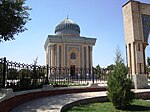Akmal al-Din al-Babarti
This is an old revision of this page, as edited by InternetArchiveBot (talk | contribs) at 18:38, 7 February 2020 (Bluelink 1 book for verifiability.) #IABot (v2.0) (GreenC bot). The present address (URL) is a permanent link to this revision, which may differ significantly from the current revision.
Akmal al-Din al-Babarti أكمل الدين البابرتي | |
|---|---|
| Personal life | |
| Born | 710 A.H. = 1310 A.D. 714 A.H. = 1314 A.D. |
| Died | 786 A.H. = 1384 A.D. |
| Era | Islamic Golden Age |
| Region | |
| Main interest(s) | Aqidah, Kalam (Islamic theology), Fiqh (Islamic jurisprudence), Usul al-Fiqh (principles of jurisprudence), Tafsir (Quranic exegesis), Hadith studies, Islamic inheritance jurisprudence, Nahw (Arabic grammar), Arabic literature, Morphology (linguistics), Rhetoric |
| Notable work(s) | Al-'Inayah Sharh al-Hidayah, Sharh Wasiyyat al-Imam Abi Hanifa |
| Religious life | |
| Religion | Islam |
| Denomination | Sunni |
| Jurisprudence | Hanafi |
| Creed | Maturidi |
| Muslim leader | |
Influenced by | |
Influenced | |
Akmal al-Din al-Babarti (Template:Lang-ar), was a Hanafi scholar, jurist, scholastic Maturidi theologian, mufassir (Quranic exegete), muhaddis (Hadith scholar), grammarian (nahawi), an eloquent orator, and prolific author with more than 40 works to his name.[3][4][5]
He was praised by several famous scholars, including Ibn Hajar al-'Asqalani, Al-Suyuti, Al-Maqrizi, Ibn Qutlubugha, Ibn Taghribirdi, Ibn al-Hinna'i, Muhammad ibn Iyas, Ibn al-'Imad al-Hanbali, and Abd al-Hayy al-Lucknawi, and the Sultan Barquq was honoring him.[6][7]
Teachers
After studying in Aleppo, he moved to Cairo in 740 A.H. (1340 A.D.) where he studied with Shams al-Din al-Isfahani (d. 749/1348), Qawam al-Din al-Kaki (d. 749/1348), Abu Hayyan al-Andalusi (d. 745/1344), Ibn 'Abd al-Hadi (d. 744/1343) and other renowned scholars.
He was appointed as professor in Cairo in the khanqah of the Amir Sayf al-Din Shaykhu/Shaykhun al-Nasiri (also al-'Umari), who was originally a member of the household of Sultan al-Nasir Muhammad b. Kalawun (d. 741/1341).[8]
Students
Among his celebrated students are Al-Sharif al-Jurjani (d. 1413) and Shams al-Din al-Fanari (d. 1430 or 1431).[9]
Books
He wrote more than 40 works in Aqidah, Kalam (Islamic theology), Fiqh (Islamic jurisprudence), Usul al-Fiqh (Principles of Islamic jurisprudence), Tafsir (Quranic exegesis), Hadith studies, Islamic inheritance jurisprudence, Nahw (Arabic grammar), Arabic literature, Morphology (linguistics), and Rhetoric.
He wrote commentary on al-Kashshaf. His other works include commentary on Mashariq al-Anwar, commentary on Mukhtasar of Ibn al-Hajib, commentary on Nasir al-Din al-Tusi's Tajrid al-I'tiqad, commentary on al-Hidaya on jurisprudence, commentary on the Alfiyya of Ibn Malik on grammar, commentary on al-Manar, and commentary on al-Bazdawi.[10]
Some of his books are as follows:[11][12]
- Al-'Inayah Sharh al-Hidayah (Template:Lang-ar).
- Sharh al-'Aqidah al-Tahawiyyah (Template:Lang-ar).
- Sharh Wasiyyat al-Imam Abi Hanifa (Template:Lang-ar).
- Sharh al-Fiqh al-Akbar by Imam Abu Hanifa (Template:Lang-ar).
- Sharh Usul Fakhr al-Islam al-Bazdawi (Template:Lang-ar).
- Sharh Mukhtasar Ibn al-Hajib (Template:Lang-ar).
- A commentary (Hashiya) on al-Kashshaf by al-Zamakhshari.
- A commentary (Hashiya) on Tajrid al-Kalam by Nasir al-Din al-Tusi.
See also
- Abu Hanifa
- Abu Mansur al-Maturidi
- 'Ala' al-Din al-Bukhari
- Badr al-Din al-Ayni
- Ibn Abidin
- Al-Maydani
- Ali al-Qari
- Shah Waliullah Dehlawi
- Muhammad Zahid al-Kawthari
- List of Hanafis
- List of Ash'aris and Maturidis
- List of Muslim theologians
References
- ^ "The Islamisation of Anatolia". University of St Andrews.
- ^ "Al-'Alam by al-Zirikli". shamela.ws.
- ^ "Al-Kashshaf: Al-Zamakhshari's Mu'tazilite Exegesis of the Qur'an by Kifayat Ullah".
- ^ "Mu'jam al-Mu'allifin by Umar Rida Kahhalah". al-maktaba.org.
- ^ "The Islamisation of Anatolia". University of St Andrews.
- ^ "Life Profile and Biography of Al-Babarti". alhaditha.net.
- ^ ابن خلدون ورسالته للقضاة مزيل الملام عن حكّام الأنام. p. 44.
- ^ "Al-Durar al-Kaminah fi A'yani al-Mi'ata al-Thaminah by Ibn Hajar Al-'Asqalani". shamela.ws.
- ^ "The Islamisation of Anatolia". University of St Andrews.
- ^ "Al-Kashshaf: Al-Zamakhshari's Mu'tazilite Exegesis of the Qur'an by Kifayat Ullah".
- ^ Sharh al-Talkhis. IslamKotob, 1970 Religion › Islam. p. 19 – via Internet Archive.
- ^ "Life Profile and Biography of Al-Babarti". alhaditha.net.
External links
- Who was Shaykh Akmalud Din? – Hadith Answers
- The Traces of the Hanafi Culture from Samarkand to Cairo
Muslim scholars of the Hanafi school | |||||
|---|---|---|---|---|---|
| 2nd/8th |
| ||||
| 3rd/9th |
| ||||
| 4th/10th |
| ||||
| 5th/11th |
| ||||
| 6th/12th |
| ||||
| 7th/13th |
| ||||
| 8th/14th |
| ||||
| 9th/15th |
| ||||
| 10th/16th |
| ||||
| 11th/17th |
| ||||
| 12th/18th |
| ||||
| 13th/19th |
| ||||
| 14th/20th |
| ||||
| 15th/21st | |||||
| Living |
| ||||
| |||||||||||||||||||||||||||||||||||||||||||||||||||||||||||||||||
| |||||||||||||||||||||||||||||||||||||||||||||||||||||||||||||||||
| International | |
|---|---|
| National | |
| Academics | |
| People | |
| Other | |

